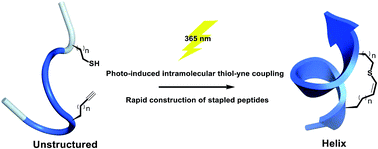Peptide stapling emerged as a versatile strategy to recapitulate the bioactive helical conformation of unstructured short peptides in water to improve their therapeutic properties in targeting intracellular “undruggable” targets. Here, we describe the development of photo-induced intramolecular thiol–yne macrocyclization for rapid access to short stapled peptides with enhanced biophysical properties. This new peptide stapling technique provides rapid access to conformationally constrained helices with satisfying functional group tolerance. Notably, the vinyl sulfide linkage shows distinct lipophilicity with reduced membrane toxicity compared to the corresponding all-hydrocarbon analogue. As a proof of principle, we constructed stabilized helices modulating intracellular estrogen receptor (ER)–coactivator interactions with a nanomolar binding affinity, enhanced serum stability, a diffuse cellular distribution and selective cytotoxicity towards ER-positive MCF-7 cells.
This article was published in the “Chemical Science” (Yuan Tian, Jingxu Li, Hui Zhao, Xiangze Zeng, Dongyuan Wang, Qisong Liu, Xiaogang Niu, Xuhui Huang, Naihan Xu* and Zigang Li* Stapling of unprotected helical peptides via photoinduced intramolecular thiol–yne hydrothiolation†,Chem. Sci., 2016, Advance Article,DOI: 10.1039/c6sc00106h)
Linking: http://pubs.rsc.org/en/content/articlepdf/2016/sc/c6sc00106h
